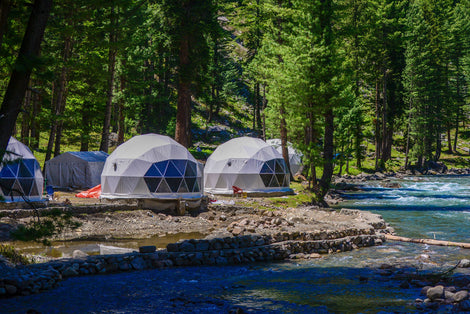Small Wind Turbine Performance in Low Wind Areas
Off-grid energy systems keep growing as more homeowners look for cleaner, self-sustained ways to power their homes. Solar tends to take the spotlight, but wind energy is gaining ground too. Small wind turbines are better built and easier to set up than ever before. They can work well as part of a mix, especially in wide-open areas.
But what happens when you don't live in a breezy spot? That’s where things get tricky. This article looks at how small wind turbines perform in low wind areas. We’ll explain how they work, why they might struggle when the air is still, and what you can do to keep your energy flowing even when wind conditions aren’t ideal.
Understanding Small Wind Turbines
Small wind turbines are built to generate energy at a smaller scale, perfect for cabins, tiny homes, and businesses that need to stay off the grid. You won’t get the huge output of those tall commercial towers, but you get a steady energy source, especially when paired with solar.
These turbines have blades that spin with the wind. The spinning turns a shaft inside which drives a generator, making electricity. That energy goes to a charge controller and then powers your batteries or runs through an inverter for direct use. It’s a straightforward system, but it hinges on one big thing—wind speed.
Nature’s Generator wind turbines are a popular option for off-grid setups. They’re known for weather-resistant housings, easy hookups, and compatibility with solar kits. Many users find them easy to install. But like all wind-based systems, performance depends mostly on your location and how the turbine is placed.
These models work best where power needs are light. They won’t carry an entire home on their own, but they can give support when the sun isn’t shining, like on winter days or during cloudy stretches. This makes them a nice backup for solar kits, as long as there’s enough steady wind to work with.
Challenges of Low Wind Areas
A low wind area is just what it sounds like—any region where wind speeds are slower or less steady than what the turbine needs. Small turbines are touchy about wind. A few miles per hour of difference can mean the difference between charging your battery and barely moving the blades.
Here’s how low wind makes things harder:
1. Reduced energy output: If the wind isn’t fast enough, your turbine might not generate anything useful.
2. Unstable charging: On-again-off-again winds can confuse your system or cause short, weak bursts of power that barely charge your battery.
3. Faster mechanical wear: Starting and stopping constantly leads to wear and tear, especially on blades and bearings made for smoother motion.
4. Overblown expectations: It's easy to think a turbine will perform better than it actually can in your area—especially without checking wind speeds ahead of time.
One customer set up a small wind turbine in a thickly wooded property for a weekend cabin. Everything looked good on paper. But summer came, and the tall trees blocked most of the airflow. It wasn’t until they raised the turbine more than 20 feet higher that it made any difference. Until then, it barely helped charge their batteries.
That’s why proper planning matters. If you live in a calm or blocked location, you’ll need to think carefully about installation and performance from the start.
Maximizing Performance in Low Wind Conditions
You can’t force the wind to blow, but you can help your turbine get the most out of what is available. Positioning is the biggest factor. The higher your turbine, the better its exposure to steadier wind. Trees, buildings, and hills can all disrupt airflow, so aim to lift the turbine well above anything nearby.
It also helps to pair placement with direction. Most turbines follow wind direction automatically, but you should still try to face common wind flows. Even seasonal shifts in wind can make a difference, so a small adjustment in your setup could bring bigger results.
Maintenance is just as key. These systems have moving parts that wear down or get dirty. Wind blades may collect ice or debris. A quick look each month and a full check twice a year can keep your turbine running longer and better.
You can upgrade or tweak your setup too:
- Blade extension kits can help catch more wind and start spinning earlier.
- Digital monitoring tech lets you watch wind speed and battery levels in real time.
- Low wind start-up controllers help the turbine produce energy even at lower speeds.
- Furling systems protect against damage in gusty wind while improving performance between lulls.
Used along with off-grid solar, wind gives you extended options. It covers nighttime gaps or stretches of bad weather. Just be honest about the system’s limits. If you don’t plan smart, you might spend money with little return.
Comparing Wind to Solar for Off-Grid Power
Solar is often the first step for off-grid energy needs. It’s quiet, needs little maintenance, and gives consistent energy when the sun’s shining. But it doesn’t work at night or during storms. Wind can step in to help smooth out those dips, especially when set up alongside your panels.
Still, wind isn't always the better choice on its own. If your area doesn't get strong winds or only sees breezes some months of the year, a solo wind solution probably won’t cut it. You'll need a full battery bank or added backup.
That's why hybrid systems are such a smart option. A setup that combines solar panels with a small wind turbine fills in the gaps. Sunlight powers your system during the day, then wind takes over when things cool down and the breeze kicks in. That means fewer times when you need to rely on backup generators.
Location matters too:
- Wide open places with steady breezes can make wind more effective than solar alone.
- Forested or shaded homes might block the sun, making wind a better backup.
- Dry and sunny zones often do best with solar, but wind can serve as a boost when weather changes.
No system is perfect year-round. But when you mix multiple sources that work at different times, you can stretch your coverage and improve daily reliability.
Smart Energy Planning for the Long Haul
Small wind turbines can be a great part of your off-grid energy mix, but they take thoughtful planning. Calm or variable winds cap what they can offer. Getting better results means knowing your land, checking wind patterns, and setting up with care.
Good placement makes a difference, as does staying on top of maintenance. Add-ons that help performance under low wind can stretch their usefulness too. But most of all, combining wind with solar gives you more balanced, dependable energy without constant stress over gaps in power.
Seasons change. So do power needs. Make time to review your setup a few times a year so your system keeps pace with how you live. Whether you’re off-grid full-time or just need a weekend retreat powered up, a mix of tools gives you a smoother path to staying self-sufficient. Wind plays its part, especially when backed by some sunshine.
If you're looking to improve your off-grid power setup, combining solar with wind can help balance energy production throughout the day and night. A Nature's Generator wind turbine complements solar kits well, especially in areas with varying weather. Explore more ways to power your home with Green Vista Living.







